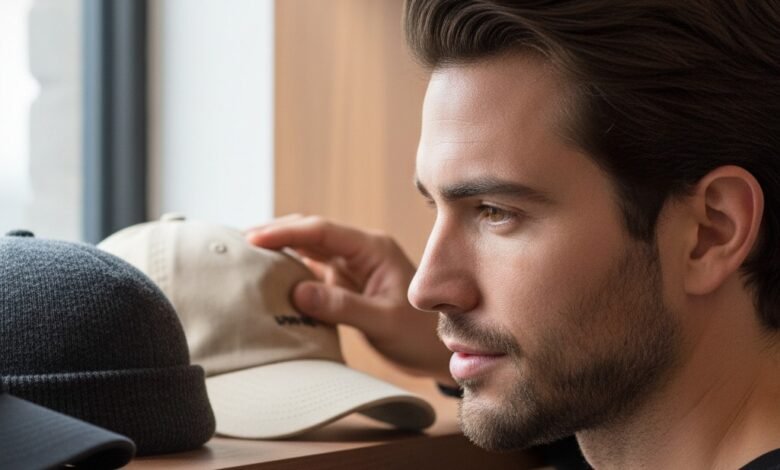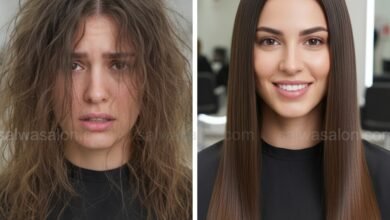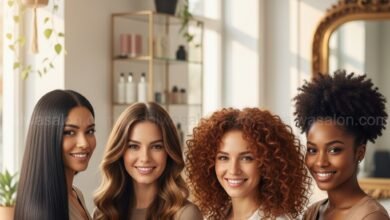A Scientific Guide to Hair Care for Men Who Wear Hats: From Scalp Health to Styling

Understanding the Paradox of Men’s Hats
Hats are not just functional accessories to protect against sun exposure; they are a style statement, a practical solution for a ‘bad hair day,’ and a key element in many men’s personal branding. However, behind these aesthetic benefits lies a paradox: an accessory designed to protect can potentially damage your crown if not balanced with proper care. Extensive hat use creates a unique microenvironment on the scalp, which, if neglected, can trigger a range of dermatological issues from dandruff, irritation, to hair loss.
As content strategists at Salwa Salon, our mission is to empower you with science-backed knowledge to navigate daily beauty challenges. This article is not just a list of tips, but a comprehensive guide outlining the ‘why’ and ‘how’ of caring for hair and scalp for you, gentlemen who make hats a part of your identity. We will break down everything from scalp health, product selection, to crucial daily habits to ensure your hair remains healthy, strong, and stylish, even after a full day under a hat.
Understanding the Problem: The Hidden Impact Behind Your Hat
Before delving into solutions, it’s crucial to fundamentally understand what problems arise on the scalp when covered by a hat for extended periods. This isn’t merely about greasy hair, but about the health of your scalp’s ecosystem.
An Ideal Microenvironment for Scalp Issues
When you wear a hat, you create an isolated environment. The temperature beneath the hat rises, and air circulation is impeded. These warm and humid conditions, caused by sweat, are a fertile breeding ground for microorganisms, especially the Malassezia globosa fungus. This fungus naturally exists on the scalp, but its overgrowth can trigger an inflammatory response, leading to irritation, itching, and an accelerated turnover of skin cells, which we know as dandruff.
Risk of Traction Alopecia and Follicle Damage
Traction Alopecia is a type of hair loss caused by constant pulling or pressure on hair follicles. Hats that are too tight, especially around the edges, exert continuous pressure on the hairline. Over time, this mechanical stress can damage follicles, weakening them, and in severe cases, permanently halting hair production. Constant friction between the hat fabric and hair strands can also damage the cuticle (the hair’s outer protective layer), making hair brittle, dull, and prone to breakage.
Accumulation of Products, Oil (Sebum), and Pollutants
The scalp naturally produces sebum to maintain moisture. Under a hat, this sebum becomes trapped along with sweat, dead skin cells, residue from styling products (pomade, gel), and environmental pollutants. This mixture can clog pores and hair follicles, a condition that can trigger folliculitis (inflammation of hair follicles), appearing as small pimples on the scalp.
The Foundation of Care: Hair and Scalp Health Protocol
Addressing the negative impacts of hat use begins with the most fundamental foundation: scalp hygiene and health. Consider this your essential routine.
- Hygiene Is Key: Frequency and Technique of Hair WashingEnsure your hair and scalp are clean before wearing a hat. This minimizes the amount of dirt and oil that will get trapped. However, “clean” doesn’t always mean shampooing every day, which can actually strip the scalp of its natural protective oils.Practical Advice: If you sweat a lot, rinse your hair with water daily to remove sweat and surface dust. Use shampoo 2-3 times a week. Choose a shampoo appropriate for your scalp type. If you’re prone to dandruff, consider a shampoo with anti-fungal ingredients like ketoconazole or zinc pyrithione. Once a month, use a clarifying shampoo for a deep cleanse of product buildup.
- Perfectly Dry Before CoveringWearing a hat when your hair is still wet or damp is a fatal mistake. Trapped moisture not only creates an ideal environment for fungi but also makes hair more vulnerable to damage. The hair cuticle swells when wet, making it more elastic but also more fragile against friction and pressure from the hat.Practical Advice: Always dry your hair thoroughly. Use a towel by gently patting, not roughly rubbing. If using a hairdryer, use a medium heat setting and finish with a cool blast of air to reseal the hair cuticles.
- The Importance of Scalp ExfoliationJust like facial skin, the scalp also needs exfoliation to remove dead skin cells, product residue, and sebum that clog pores. This will improve blood circulation to the follicles and ensure better nutrient absorption.Practical Advice: Exfoliate your scalp once a week. You can use a physical scalp scrub (with fine granules) or a chemical exfoliant containing salicylic acid (BHA) or glycolic acid (AHA), which help dissolve dead skin cell bonds.
Smart Styling Strategies and Material Selection
Care doesn’t stop at hygiene. Your choice of hairstyle, products, and the type of hat you wear has a significant impact.
- Choosing a “Hat-Friendly” HaircutHairstyles that are too thick and voluminous will become greasy more easily and be difficult to restyle after the hat is removed. Shorter and thinner hairstyles on the sides and back (such as an undercut or fade) reduce pressure and friction from the hat’s rim, and also maintain better air circulation.
- Styling Product Composition: Prioritize Water-BasedIf you use pomade, its composition is very important. Oil-based pomades, often containing petrolatum or lanolin, are occlusive (clogging). When mixed with sweat, they create a thick layer that is difficult to clean from both the hair and the inside of the hat. This residue can become a breeding ground for bacteria.Practical Advice: Switch to water-based products. These types of pomades, clays, or waxes are much easier to rinse with water, leave no sticky residue, and are more ‘breathable’ for the scalp. Although their hold might be slightly less than oil-based products, your scalp’s long-term health is the priority.
- Hat Material: Prioritize Air Circulation (Breathability)The material of your hat determines how well your scalp can breathe. Synthetic materials like polyester or nylon tend to retain heat and moisture. Conversely, natural fibers allow for better air exchange.Practical Advice: Choose hats made from 100% cotton, linen, or wool. These materials are breathable and capable of effectively wicking away moisture, keeping the scalp dry and cool.
Conclusion: Harmony Between Style and Hair Health
Being a loyal hat wearer doesn’t mean you have to sacrifice hair health. The key lies in a proactive and holistic approach. By understanding the scientific impacts occurring under a hat and adopting appropriate care protocols—ranging from deep cleansing, regular exfoliation, smart product selection, to hat material preferences—you can achieve perfect harmony between personal style and vital hair health. Remember, a hat is an accessory for healthy hair, not a cover for problematic hair. Nurture the foundation, and style will follow.






